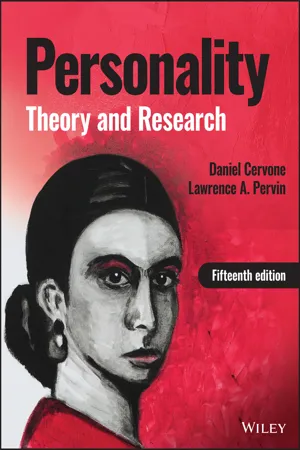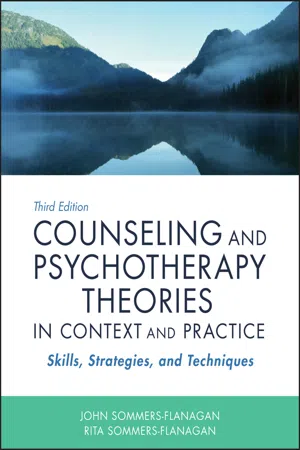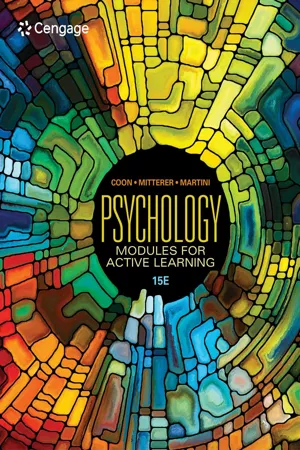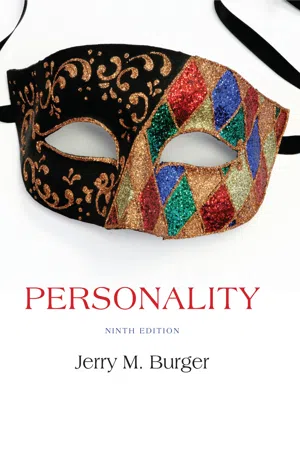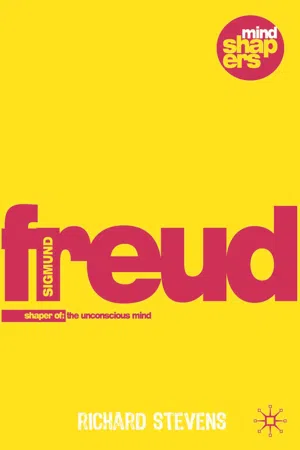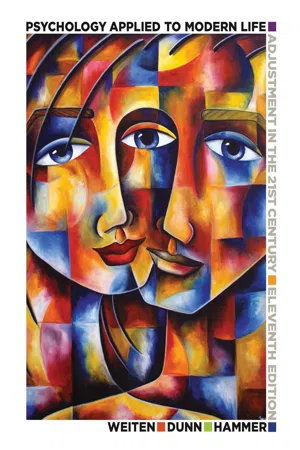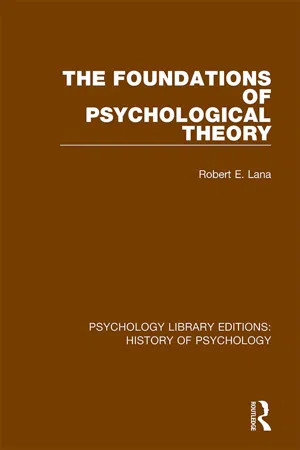Psychology
Psychoanalytic Theory of Personality
The Psychoanalytic Theory of Personality, developed by Sigmund Freud, suggests that human behavior is influenced by unconscious drives and conflicts. It emphasizes the role of early childhood experiences and the interplay between the id, ego, and superego in shaping personality. This theory has had a significant impact on the field of psychology, particularly in understanding the complexities of human behavior and personality development.
Written by Perlego with AI-assistance
Related key terms
1 of 5
10 Key excerpts on "Psychoanalytic Theory of Personality"
- eBook - PDF
Personality
Theory and Research
- Daniel Cervone, Lawrence A. Pervin(Authors)
- 2022(Publication Date)
- Wiley(Publisher)
57 3 Questions to Be Addressed in This Chapter Sigmund Freud (1856–1939): A View of the Theorist Freud’s View of the Person Freud’s View of the Science of Personality Freud’s Psychoanalytic Theory of Personality Major Concepts Review A Psychodynamic Theory: Freud’s Psychoanalytic Theory of Personality Chapter Focus The number one player on the tennis team is getting ready to play for the state title. She has never met her opponent before, so she decides to introduce her- self before the match. She strolls onto the court where her opponent is warming up and says. “Hi, I’m Amy. Glad to beat you.” You can imagine how embar- rassed Amy was! Flustered, she corrected her innocent mistake and walked over to her side of the court to warm up. “Wow,” Amy thought, “where did that come from? ” Was Amy’s verbal slip so innocent? Freud wouldn’t have thought so. In his view, Amy’s silly mistake was actually a very revealing display of unconscious aggressive drives. Freud’s psychoanalytic theory is illustrative of a psychody- namic and clinical approach to personality. Behavior is interpreted as a result of the dynamic interplay among motives, drives, needs, and conflicts. The research consists mainly of clinical investigations as shown in an emphasis on the individual, in the attention given to individual differences, and in attempts to assess and understand the total individual. Contemporary researchers, however, devote much attention to the challenge of studying psychodynamic processes in the experimental laboratory. A PSYCHODYNAMIC THEORY: FREUD’S PSYCHOANALYTIC THEORY OF PERSONALITY 58 Questions to Be Addressed in This Chapter 1. How did Freud develop his theory, and how did historical and personal events shape this development? 2. What are the key features of Freud’s theoretical model of the human mind? 3. - eBook - PDF
Counseling and Psychotherapy Theories in Context and Practice
Skills, Strategies, and Techniques
- John Sommers-Flanagan, Rita Sommers-Flanagan(Authors)
- 2018(Publication Date)
- Wiley(Publisher)
INTRODUCTION Contemporary psychoanalytic psychotherapy is based on the writing and theories of Sigmund Freud. However, beyond Freud, many other writers, practitioners, and cli-ents have contributed to the vastly different ways in which psychoanalytic psychotherapies are practiced today. What Is Psychoanalytic Psychotherapy? This is a question with many answers. Sigmund Freud developed psychoanalysis and psycho-analytic theory. Although he had stimulating discussions of his theory and approach with others while he was alive, Freud had the final word. Psychoanalysis is the term used to describe Freud’s approach and classical Freudian psychoanalytic theory is his theoretical model. Classical Freudian psychoanalytic theory is a one-person intra-psychic model where the psychotherapist acts as a blank slate and listens for unconscious conflicts and motivations that underlie repetitive, maladaptive patterns of behavior. Many other psychoanalytic and psychodynamic psy-chotherapies developed from Freud’s original theorizing. These include, but are not limited to: (a) ego psychology, (b) object relations, (c) self psychology, and (d) relational (or two-person) psychoanalysis. These are broadly referred to as modern psychoanalytic approaches . Modern psychoanalytic practitioners generally treat therapy as a two-person field, where the psychotherapist’s and client’s unconscious, intrapsychic, and relationship interactions are used to shed light on interpersonal patterns that are trou-bling the client (Bass, 2015; Renik, 1993; Wachtel, 2010). The most general term is psychodynamic psycho-therapy. Psychodynamic psychotherapy refers to approaches that emphasize unconscious behavior pat-terns and use insight as a primary therapeutic tool for psychological change. Counseling and Psychotherapy Theories in Context and Practice: Skills, Strategies, and Techniques, Third Edition. John Sommers-Flanagan and Rita Sommers-Flanagan. © 2018 John Wiley & Sons, Inc. - eBook - PDF
Psychology
Modules for Active Learning
- Dennis Coon, John Mitterer, Tanya Martini, , Dennis Coon, John Mitterer, Tanya Martini, (Authors)
- 2021(Publication Date)
- Cengage Learning EMEA(Publisher)
As a doctor, Freud was fascinated by patients whose problems Psychoanalytic Theory—Id Came to Me in a Dream After reading this module you should be able to: 52.1 Describe how psychodynamic theories explain personality 52.2 Describe how humanistic theories explain personality ~LEARNING OUTCOMES~ The Why of Personality Shai Halud/Shutterstock.com Copyright 2022 Cengage Learning. All Rights Reserved. May not be copied, scanned, or duplicated, in whole or in part. Due to electronic rights, some third party content may be suppressed from the eBook and/or eChapter(s). Editorial review has deemed that any suppressed content does not materially affect the overall learning experience. Cengage Learning reserves the right to remove additional content at any time if subsequent rights restrictions require it. 453 MODULE 52 PERSONALITY: PSYCHODYNAMIC AND HUMANISTIC THEORIES The Structure of Personality How did Freud view personality? Freud’s model portrays per-sonality as a dynamic system directed by three mental struc-tures: the id , the ego , and the superego . According to Freud, most behavior involves activity of all three systems. The Id The id contains primitive drives present at birth. The id operates on the pleasure principle . It is self-serving, irrational, impulsive, and totally unconscious—that is, it seeks to avoid pain and freely express pleasure-seeking urg-es of all kinds. If we were solely under control of the id, the world would be chaotic beyond belief. The id acts as a power source for the entire psyche (SIGH-key), or personality. This energy, called libido (lih-BEE-doe), flows from Eros , the life instincts. According to Freud, libido underlies our efforts to survive, as well as our sexual desires and pleasure seeking. Freud also described Thanatos , the “death” instinct — although today it is more often thought of as an impulse toward aggression and destructive urges. Freud offered humanity’s long history of wars and violence as evidence of such urges. - eBook - PDF
- Richard Ryckman(Author)
- 2020(Publication Date)
- Cengage Learning EMEA(Publisher)
Psychological anthropologists focus on child-rearing practices in various cultures and often use a Freudian model to understand adult personality. Philosophers and sociologists have used the Freudian concepts of repression and anxiety in their analyses of pro- blems confronting modern society. Freudian concepts have also been adopted by laypeople. We are all aware of the importance of Freudian slips and the ways in which the unconscious influences behavior. Sometimes we talk glibly about ego trips, denial, and Oedipal conflicts; we might speak of “getting it all out” when we are angry. In short, Freudian thinking has had a revolutionary impact on our lives. Whether we ultimately accept or reject his view of human behavior and functioning, Freud has clearly earned his place in history. In Chapter 2, we review the basic concepts of Freud’s theory. We examine his attempts to construct a theory of personality based on interpretations of self-reports by his patients. We describe the basic constructs (the unconscious, 19 Copyright 2013 Cengage Learning. All Rights Reserved. May not be copied, scanned, or duplicated, in whole or in part. Due to electronic rights, some third party content may be suppressed from the eBook and/or eChapter(s). Editorial review has deemed that any suppressed content does not materially affect the overall learning experience. Cengage Learning reserves the right to remove additional content at any time if subsequent rights restrictions require it. preconscious, and conscious; the life and death instincts; the id, ego, and super- ego), how they interact to produce internal conflicts, and the various defense mechanisms used to protect the ego and reduce the anxiety generated by these conflicts. We review Freud’s theory of psychosexual development, with special emphasis on the origins and nature of the various character disorders. - eBook - PDF
- Jerry Burger, , , , Burger(Authors)
- 2014(Publication Date)
- Cengage Learning EMEA(Publisher)
C H A P T E R 5 The Psychoanalytic Approach Neo-Freudian Theory, Application, and Assessment Limits and Liabilities of Freudian Theory Alfred Adler Carl Jung Erik Erikson Karen Horney Application: Psychoanalytic Theory and Religion Assessment: Personal Narratives Strengths and Criticisms of Neo-Freudian Theories Summary 94 Copyright 2015 Cengage Learning. All Rights Reserved. May not be copied, scanned, or duplicated, in whole or in part. Due to electronic rights, some third party content may be suppressed from the eBook and/or eChapter(s). Editorial review has deemed that any suppressed content does not materially affect the overall learning experience. Cengage Learning reserves the right to remove additional content at any time if subsequent rights restrictions require it. Historians, scholars, teachers, and textbook writers use a number of images and metaphors to describe Sigmund Freud ’ s work and influence. Some picture Freud defiantly marching against the stream of contemporary thought and values. Others describe him as a pioneer blazing new trails into the previously unknown territory of the unconscious mind. I ’ ve also seen Freud compared with a diligent detective piecing together clues about the true nature of the human mind or a shrewd lawyer cutting away the ego ’ s defenses one by one. But the metaphor I like best compares Freud with a tree. Like a giant oak stand-ing in the middle of a grove, Freud ’ s theory is the oldest and most formidable of the many psychoanalytic approaches to understanding personality. Just as the oak drops acorns that sprout into their own trees, so did Freud ’ s Psychoanalytic Society generate several scholars who went on to develop their own theories of personality. However, like the surrounding saplings that resemble the great oak, the ancestry of these later personality theories is clearly Freudian. The collection of scholars who gathered in Vienna to study with Freud included some of the leading thinkers of the day. - No longer available |Learn more
- Duane P. Schultz; Sydney Ellen Schultz, Duane Schultz, Sydney Schultz(Authors)
- 2020(Publication Date)
- Cengage Learning EMEA(Publisher)
Ambiguous definitions of certain Freudian concepts have also been questioned. Critics point to confusion and contradiction in such terms as id, ego, and superego. Are they distinct physical structures in the brain? Are they fluid processes? In his later writings Freud addressed the difficulties of defining some of his concepts precisely, but the ques-tions remain. Freud ’ s Lasting Influence This book is a history of modern insights into personality. In our personal and social growth we are never free of our past, nor should we want to be. The past offers the foun-dation on which to build, as later personality theorists have built on Freud ’ s work. If psychoanalysis has served no other purpose than to inspire others and provide a frame-work within which to develop new insights, then Freud ’ s importance to the world of ideas is secure. Every structure depends on the soundness and integrity of its foundation. Sigmund Freud gave personality theorists a highly original, stimulating, and challenging base on which to build. Chapter Summary Freud ’ s theory is at least partly autobiographical in that he based some of his major concepts on his childhood experiences, dreams, and sexual conflicts. Instincts are mental representations of stimuli that originate within the body. Life instincts serve the pur-pose of survival and are manifested in a form of psychic energy called libido. Death instincts are an unconscious drive toward decay, destruction, and aggression. The three structures of the personality are the id, ego, and superego. The id, the biological component of per-sonality, is the storehouse of instincts and libido. It oper-ates in accordance with the pleasure principle. The ego, the rational component of personality, operates in accor-dance with the reality principle. The superego, the moral side of personality, consists of the conscience (behaviors for which the child is punished) and the ego-ideal (beha-viors for which the child is praised). - eBook - PDF
- Jerry Burger(Author)
- 2018(Publication Date)
- Cengage Learning EMEA(Publisher)
3 DNY59/E+/Getty Images 5 Limits and Liabilities of Freudian Theory Alfred Adler Carl Jung Erik Erikson Karen Horney Application: Psychoanalytic Theory and Religion Assessment: Personal Narratives Strengths and Criticisms of Neo-Freudian Theories Summary Neo-Freudian Theory, Application, and Assessment The Psychoanalytic Approach Copyright 2019 Cengage Learning. All Rights Reserved. May not be copied, scanned, or duplicated, in whole or in part. Due to electronic rights, some third party content may be suppressed from the eBook and/or eChapter(s). Editorial review has deemed that any suppressed content does not materially affect the overall learning experience. Cengage Learning reserves the right to remove additional content at any time if subsequent rights restrictions require it. 82 Chapter 5 / The Psychoanalytic Approach H istorians, teachers, and textbook writers use a number of images and metaphors to describe Sigmund Freud’s work and influence. Some picture Freud a defiant insurgent marching against the stream of contemporary thought and values. Others describe him as a pioneer blazing new trails into the previously unknown territory of the unconscious mind. I’ve also seen Freud compared with a diligent detective piecing together clues about the true nature of the human mind or a shrewd lawyer cutting away the ego’s defenses one by one. But the metaphor I like best compares Freud with a tree. Like a giant oak standing in the middle of a grove, Freud’s the- ory is the oldest and most formidable of the many psychoanalytic approaches to understanding personality. Just as the oak drops acorns that sprout into their own trees, so did Freud’s Psychoanalytic Society generate several scholars who went on to develop their own theories of personality. However, like the surrounding saplings that resemble the great oak, the ancestry of these later personality theories is clearly Freudian. - eBook - PDF
Sigmund Freud
Examining the Essence of his Contribution
- Richard Stevens(Author)
- 2017(Publication Date)
- Red Globe Press(Publisher)
This development has taken various forms. Some, like Anna Freud and Hartmann have been concerned with extend-ing Freud’s original ideas about defence mechanisms and the ego. Others, like Fromm, have moved more to an existential position and have worked from the implications of the human capacity for aware-ness of existing. 3. The third kind of development is greater concern with the impact of culture on personality. Both Horney and Fromm, for example, have been active in this respect. Some theorists come into more than one category. Erikson, for example, has developed psychoanalysis in all three of these directions. Not only has he focused on the significance of the ego, but he has traced the changing phases of its development throughout life from childhood to old age and has been concerned to explore its strengths as well as its defences. His theory is also at heart psychosocial – he explores the complex ways in which the social context may shape and interact with the sequence of personal development. Although these variants of Freudian theory differ in their emphases and often also in the concepts which they employ, there are nevertheless basic features which are common to them all. For example, all are dynamic. They accept that behaviour is goal-directed and subject to conflicts which, in Freud’s Progeny – Developments in Psychoanalysis 85 turn, influence personality and behaviour. All assume too that behaviour and experience are affected by unconscious motivations and that child-hood experience and development have important consequences for adult personality. If the preceding accounts of the different developments of psychoanalytic theory have not been particularly evaluative, it is because they are fundamentally similar in terms of their epistemological status. Much of the general evaluation of the nature of psychoanalytic theory which follows in Part Two will apply to them as well. - No longer available |Learn more
Psychology Applied to Modern Life
Adjustment in the 21st Century
- Wayne Weiten, Dana Dunn, Elizabeth Hammer(Authors)
- 2014(Publication Date)
- Cengage Learning EMEA(Publisher)
He maintained that future devel- opments are rooted in early, formative experiences and that significant conflicts in later years are replays of crises from childhood. In fact, Freud believed that unconscious sexual con- flicts rooted in childhood experiences cause most personal- ity disturbances. His steadfast belief in the psychosexual origins of psychological disorders eventually led to bitter theoretical disputes with two of his most brilliant col- leagues: Carl Jung and Alfred Adler. They both argued that Freud overemphasized sexuality. Freud summarily re- jected their ideas, and the other two theorists felt com- pelled to go their own ways, developing their own psycho- dynamic theories of personality. Jung’s Analytical Psychology Swiss psychiatrist Carl Jung called his new approach ana- lytical psychology to differentiate it from Freud’s psycho- analytic theory. Like Freud, Jung (1921, 1933) emphasized the unconscious determinants of personality. However, he proposed that the unconscious consists of two layers. The first layer, called the personal unconscious, is essentially the same as Freud’s version of the unconscious. The personal unconscious houses material from one’s life that is not within one’s conscious awareness because it has been re- pressed or forgotten. In addition, Jung theorized the exis- tence of a deeper layer he called the collective unconscious. The collective unconscious is a storehouse of latent memory traces inherited from people’s ancestral past that is shared with the entire human race. Jung called these ancestral memories archetypes. They are not memo- ries of actual, personal experiences. Instead, archetypes are emotionally charged images and thought forms that have universal meaning. These archetypal images and ideas show up frequently in dreams and are often manifested in a culture’s use of symbols in art, literature, and religion. Jung felt that an understanding of archetypal symbols Learn More Online C. - eBook - ePub
- Robert E. Lana(Author)
- 2019(Publication Date)
- Routledge(Publisher)
6Personality Theory
Virtually all personality theories have a sense of self at their epistemological core.1 The inclusion of the concept of self in a theory is accompanied by an attempt to explain aspects of human existence from the individual’s point of view. If self is taken as the core concept of a system, one’s place in the world is of central importance. Because most personality theories deal with self, they almost always have a phenomenological quality in much of their conceptualization, even though they may include causal analysis. This phenomenal quality emerges because most personality theories yield psychotherapies that involve a strong sense of immediate experience. This therapeutic by-product is a function of the fact that, historically, clinical psychologists and psychiatrists have developed these theories. As we shall see, the impetus given by Freud was so great as to link psychotherapies with personality theories for many years afterward.Because personality theories are focused upon a complicated and sometimes illusive concept of self, they run a constant risk of excluding more mundane characteristics which may, nevertheless, be of significance. This limitation is offset by the fact that personality theories have a relevance to experienced life that is often missing in theories of other psychological phenomena.THE PERSONALITY SYSTEM OF SIGMUND FREUD
Freud worked with many people suffering from classical neurotic symptoms. This directed Freud’s interests and theoretical tendencies toward building a personality theory with a derivative psychotherapy that could explain both normal and abnormal behavior (Freud, 1959, 1960a, b). His biological interests as a medical researcher in a variety of other fields were consistent with his assumption that a full understanding of human existence must begin with the most fundamental biological systems of the organism. As we have seen, Nietzsche had already established the importance of the primordial motivational aspects of human existence, a context in which Freud became theoretically comfortable by the early part of the twentieth century. Freud sought the basic motivations of human beings in the appetitive systems. He believed these systems interacted with the immediate social conditions of mother and child given at birth. He combined these observations and developed a causative deterministic system, which sought to enumerate essentially immutable patterns in human development.
Index pages curate the most relevant extracts from our library of academic textbooks. They’ve been created using an in-house natural language model (NLM), each adding context and meaning to key research topics.
